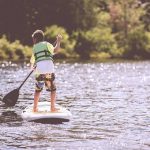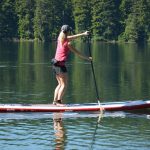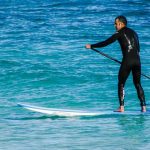Looking for a fun and exciting way to get out on the water this summer? Stand-up paddleboarding (SUP) is a great option for beginners!
Not only is it an excellent full-body workout, but it’s also a great way to explore the great outdoors and enjoy the beauty of nature. If you’re new to SUP, there are a few tips and tricks that can help you get started on the right foot.
In this article, we’ll cover everything you need to know to get started with stand-up paddleboarding, including how to choose the right board, basic paddling techniques, and safety tips to ensure a fun and successful experience on the water.
So grab your sunscreen, strap on your board, and let’s get started!
What Is Stand Up Paddle Boarding?
Paddle boards are fundamentally different from canoes and kayaks as they are totally flat boards which you can use for paddling while you are standing, kneeling, or sitting down.
SUP paddles are like regular canoe paddles in that they have a blade on one end and a handle on the other, but they are longer than other paddles, allowing you to stand fully upright when using them.
Stand up paddle boarding has become more popular in recent years due to its peaceful, entertaining, and interactive nature when paddling on different bodies of water* like seas, lakes, bays, and rivers. *Options: ‘lakes, seas, rivers, and bays’
You can engage in other pursuits on a paddle board, such as SUP yoga or try your hand at some wave surfing.
How To Paddle Board
Gaining correct skills in paddle boarding is essential for obtaining full strength and rotation when paddling, as well as enhancing your stability. This will enhance your rowing velocity and supply you with more of an exercise. Gaining expertise in the applicable methodology will offer you improved restriction over your skateboard and will let you evade more skilfully.
Below are a few paddle boarding beginner basics:
Beginning a journey with stand up paddle boarding can seem intimidating. It is essential to take in a great deal of data before you grab a paddle and blow up the board.
In our handbook, we’ll discuss our prime 12 proposals for incoming paddle boarders. By the time you get to the end, you’ll know things like:
- What to do if the weather changes and the winds are too strong for you to paddle against.?
- How to choose equipment that’s right for your skill level?
- How to hold your paddle and stand on your board correctly?
- Why you need to wash your board after every session?
HOW TO STAND ON A PADDLE BOARD
- Stand next to the board in shallow water. Keep an eye on the fin so it’s not dragging on the bottom.
- Place your paddle down across the board
- Attach the ankle leash if there is one
- Plant your hands firmly on the paddle and kneel on the board just behind the board’s halfway point
- When you feel like you are balanced, slowly stand up
- Position yourself so you’re standing at the center of the board – it should be flat on the water with neither the nose or tail lifting up or pushing into the water
- Your feet should be facing forward about hip-distance apart or wider with knees slightly bent
HOW TO HOLD A PADDLE BOARD PADDLE
- Grip the T bar at the top of the paddle with one hand and place your other hand at a comfortable distance about halfway down the paddle
- The angle in the paddle blade should face away from you, which is the opposite of how you would hold a kayak paddle.
HOW TO PADDLE A SUP
- Keep your core engaged to help with your balance
- Keep your arms straight as you extend the paddle forward for each stroke
- Make 4-5 short, close strokes on each side of the board and then switch sides and reverse your hand positions
- To turn, keep paddling on one side (paddling on the right will cause you to go left). Or for a quicker turn, drag your paddle backward on the side you want to turn in the direction of
One of the advantages of paddle boarding when compared to kayaking or canoeing is that you have numerous ways that you can use it. One can learn how to paddle board while standing as described above, but one can also paddle board while either kneeling or sitting on their board.
Novice stand up paddle board enthusiasts can explore different styles and techniques to find what suits them best or feels most natural. Once you reach the water, you can kick back and take it easy by lying down on top of your paddle board.
A useful alternative is a compactable seat which can be employed to sit on a paddle board and paddle in a canoe-style position should you become exhausted or finding it difficult to stay upright when standing.
Ready to jump in and upskill your SUP knowledge? These are some of the greatest pieces of advice for stand-up paddle boarding which will help you become a wave-riding expert in a short period of time!
8 stand up paddle boarding tips for beginners
1. BUY A LEASH
No matter if you’re a beginner or an expert in stand-up paddle boarding, you must purchase a leash.
Why?
- It will save you from having to swim after your board.?
- You won’t lose it in windy or stormy conditions.?
- It will stop you from hitting other surfers with your board by mistake.?
Various types of restraining straps are available that are suitable for your paddling technique. You have the option of selecting either a straight or a curved version, and either a leg or a shin attachment.
When shopping for a SUP leash, the length of it should be a priority. If you plan to SUP in rough water for an extended period, you’ll need a longer cord to prevent the board from striking you if you tumble off.
Another point to think about is the simplicity of detaching the leash. If you get ensnared in underwater vegetation, you need a tether that you can release yourself from quickly.
2. INVEST IN YOUR STAND-UP PADDLE BOARD GEAR
In order to optimise your time on a stand-up paddle board, you must purchase gear that matches your ability level from the start.
Those who are just starting out with SUP should opt for a board that is broad, long, and thick. It will assist you in becoming proficient in maintaining equilibrium in various aquatic environments.
Another board option for beginners is a touring SUP. This is a type of board that will match with your aptitude development, and you can bring it out when you believe you are able to advance at a quicker rate and speed.
When selecting a paddle, it is best to choose one 10 inches longer than your height in order to ensure a secure and comfortable grip.
3. CHECK THE WEATHER AND WIND REPORTS
Paddling against forceful winds can quickly drain your energy when you’re on the water. When you are learning how to paddleboard, it is preferable to practice when the wind is not excessively strong and the waves are not too large.
Strong winds will make it more challenging to maintain your equilibrium while paddling to your intended destination.
Before entering into the water, it would be wise to check the day’s weather forecast. You might consider taking advantage of Windy, Magic Seaweed and Swellnet – three top-notch applications and websites. These will give you accurate wind and swell predictions.
If you’re out boating and the gusts become stronger, you can utilize an experienced paddling method to make it back to land securely. Lay flat on your surfboard with your paddle under you, and propel yourself toward the beach with your arms.
4. LEARN HOW TO HOLD THE PADDLE CORRECTLY
Among the most significant errors committed by first-time paddle boarders is their lack of proficiency with their paddle.
If you have never had experience with stand-up paddle boarding, you won’t know how to properly use the paddle for optimal strokes or in which direction you should hold the blade.
Here are some tips on how to use your SUP paddle correctly:
- Hold your paddle so that the bent part of the blade is facing away from you.?
- Your paddle should always be perpendicular to your board when it’s in the water.?
- Always hold the paddle with your hand gripping the top of the handle and the other on the shaft.?
- Make sure your grip is shoulder-width apart, so you get more power out of your strokes.?
- Don’t only rely on your arms to paddle. When you dip the blade fully into the water to take a stroke, let your back muscles and core do most of the work.?
5. LEARN THE PROPER TECHNIQUE FOR STANDING ON THE PADDLE BOARD
For those who are just beginning to paddle board, the hardest part to master will be keeping their balance. Nevertheless, there are some steps you can take to simplify matters and spend more time gliding on the surface than submerged beneath the waves.
Avoid a surfing orientation when you are using your stand-up paddleboard, as it will significantly impede your ability to paddle regardless of the conditions. Maintain your feet in line, with your shoulders apart, and aim the points of your toes towards the front edge of your skateboard.
It is advised to not take your focus away from the horizon while you are paddling as it can make it difficult to maintain your equilibrium. A way to get past this issue is to focus on the line of the horizon or identify something far away and row towards it.
Stay neither too far in front nor behind the board; it will make it difficult to manage it. Stand at locations indicated by the carry handles.
6. FACE THE RIGHT DIRECTION
It can be troublesome for those starting out with all-around boards to identify which end is the front. If you’re uncertain, ensure the fins are located on the rear of the board.
The fins work to maintain directional stability when paddling and provide traction when riding waves.
Another indication that your paddleboard is not properly aligned could be if you experience difficulty in maintaining it in a straight line, requiring you to frequently change the side of the paddle. If you sense this, it is most likely because your flippers are located in the front.
When you’re in a boat, it’s not a good idea to be in the direct beams of the sun for an extended period. The hot temperature can separate your hardboard and lead to damage in the joints of your inflatable stand-up paddleboard.
7. USE YOUR CORE STRENGTH
Stand-up paddle boarding requires the use of more than just your arms and back muscles. A full-body exercise routine which needs lots of core muscular strength is necessary.
While paddling, it is important to activate your abdominal muscles to propel the paddle firmly and to maintain your balance.
As well, with the passage of time, you’ll begin to establish muscular shape in your torso!
8. FALL OFF YOUR BOARD THE RIGHT WAY
You never stop falling off your paddle board. This activity allows you to become more composed and steady in your actions, though even the most experienced still need to strive to remain balanced.
Gaining the knowledge of how to descend in a secure way is an essential skill for stand up paddle boarding. You want to jump off your board to stop any part of your body from coming into contact with the board or fins.
It is suggested that you try falling off your board so that you may prevent ending your session prematurely due to an injury.
And don’t worry about your board. You can stop worrying about your surfboard drifting away if you own a leash.
Types of Paddle Boards
There are two varieties of paddle boards: rigid and blow-up. If you are renting a stand up paddle board, it will most likely be a hard one. Nevertheless, blow-up paddle boards are becoming increasingly favored for their cost-effectiveness, their capacity to be packed away, and their versatility. Here are a few key differences between solid and inflatable paddle boards:
SOLID PADDLE BOARDS
- Pros: best performance on the water, no time to set up, more stable, less effort to paddle, easier to custom fit
- Cons: More challenging to store and transport
Bearfoot Theory Pick: Surftech Bark Catalyst Tuflite V-Tech Stand Up Paddle Board
This Surftech Bark Catalyst Tuflite V-Tech Stand Up Paddle Board is an excellent option for novices to paddle boarding as it offers steadiness, enduringness, and adaptability. Whether you plan to surf on a body of water such as a lake, river, or even in the open sea, this board will ensure that you have a secure and comfortable ride.
INFLATABLE PADDLE BOARDS
- Pros: easily stored and transported, softer and more comfortable to sit or do yoga on, can paddle more places (like a short hike to a lake), better suited for rapids
- Cons: inflating and deflating is time-consuming, less stability
Bearfoot Theory pick: Bote Breeze Aero Inflatable Stand Up Paddle Board
Our first selection for an inflatable SUP is the Bote Breeze Aero Stand Up Paddle Board. This product is great for adventuring in water due to its portability and low weight. When the backpack is packed, it is almost 22 pounds and is easy to haul on a hike or store in the trunk of your car.




